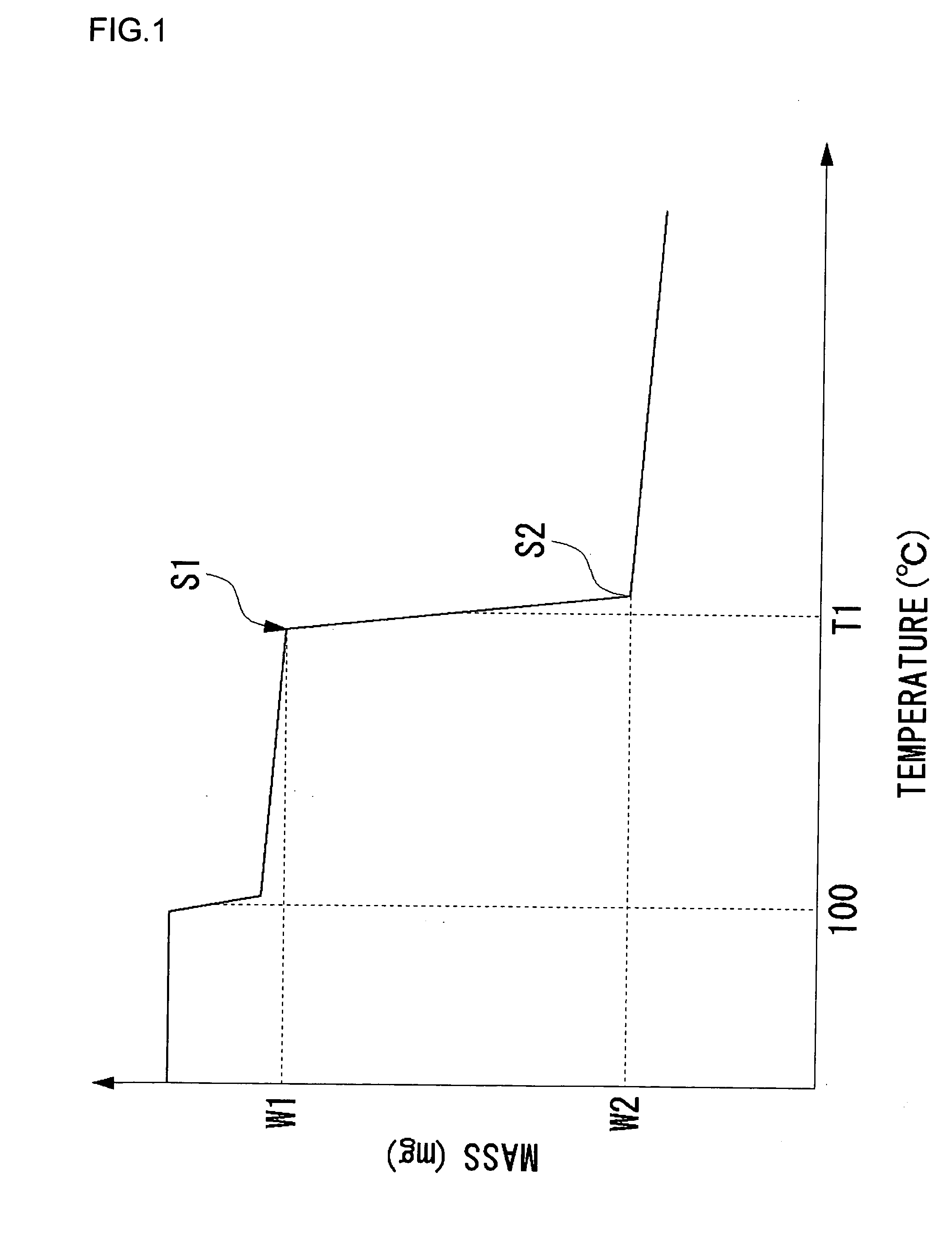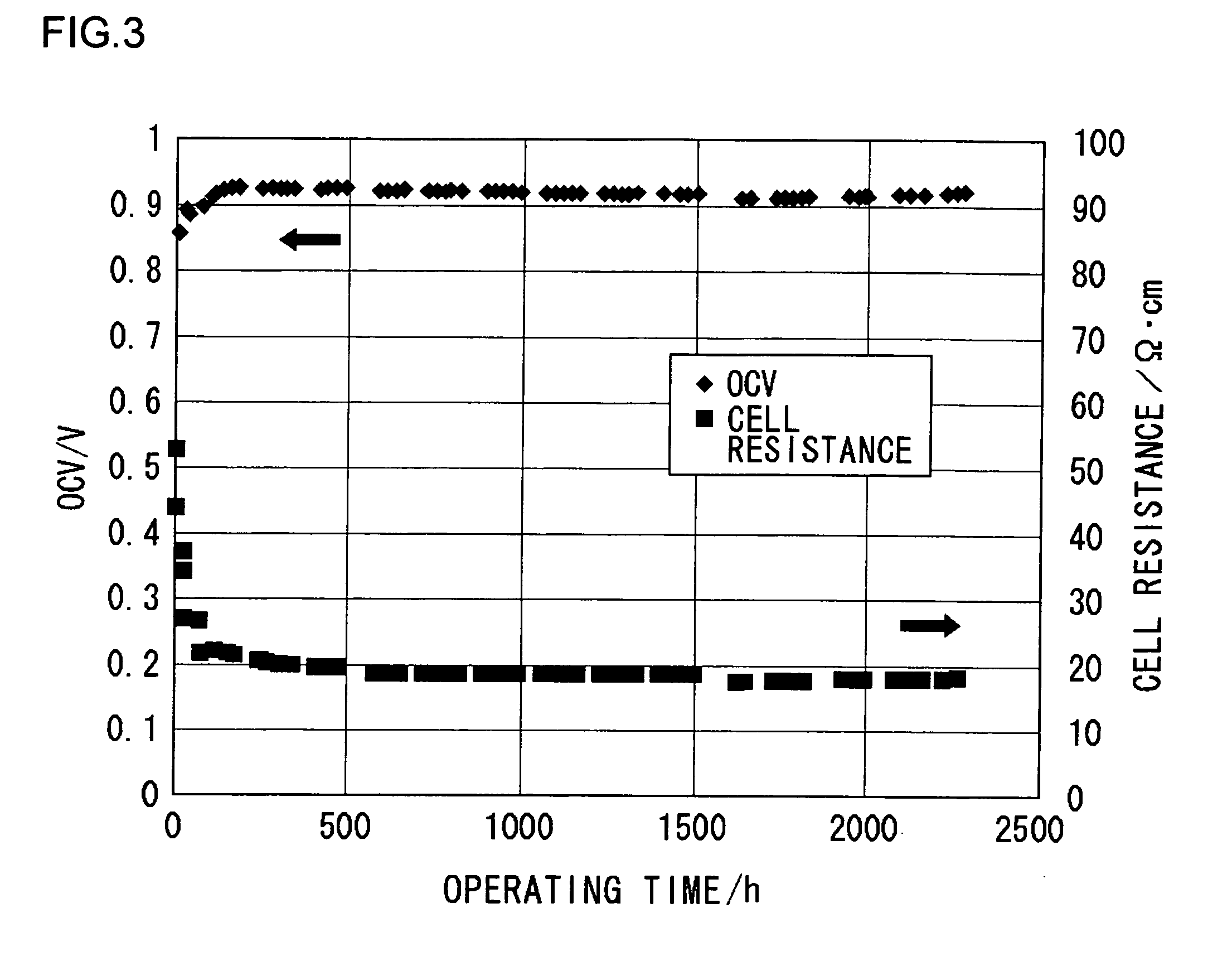Fuel cell electrolyte, membrane electrode assembly, and method of manufacturing fuel cell electrolyte
a fuel cell and electrolyte technology, applied in the field of fuel cells, can solve the problems of complex and large-scale fuel cell systems, manufacturing difficulties, and shrinkage of basic polymer membranes, and achieve the effect of improving gas diffusibility and reducing wrinkle production
- Summary
- Abstract
- Description
- Claims
- Application Information
AI Technical Summary
Benefits of technology
Problems solved by technology
Method used
Image
Examples
embodiment 1
[0041] A fuel cell electrolyte according to the present embodiment contains a basic polymer and an organic phoshonic acid compound expressed by the following general formula (4):
where R represents an alkyl, aryl, acyl, amino, phosphonic group or a derivative of the functional group, and n is 1 or 2.
[0042] (Basic Polymer)
[0043] The basic polymer is preferably selected from the group consisting of polybenzimidazoles, poly(pyridines), poly(pyrimidines), polyimidazoles, polybenzothiazoles, polybenzoxazoles, polyoxadiazoles, polyquinolines, polyquinoxalines, polythiadiazoles, poly(tetrazapyrenes), polyoxazoles, polythiazoles, polyvinylpyridines, and polyvinylimidazoles.
[0044] It is preferable that the basic polymer be cross-linked by a cross-linking agent. Cross-linking the basic polymer improves the rigidity of the fuel cell electrolyte and controls elasticity. Any cross-linking agent suitable for the cross-linking reaction of the basic polymer may be employed. For example, uretha...
embodiment 2
[0061] A membrane electrode assembly according to the present embodiment is obtained by joining an anode to one of the sides of the foregoing fuel cell electrolyte, and joining a cathode to the other side of the fuel cell electrolyte.
[0062] The membrane electrode assembly of the present embodiment is characterized in that at least one of the anode and the cathode contains an organic phosphonic acid expressed by the foregoing general formula (4). The membrane electrode assembly of the present embodiment is composed of the fuel cell electrolyte which has a level of proton conductivity equivalent to that of conventional fuel cell electrolytes while dimensional changes and wrinkles thereof are suppressed. Consequently, manufacturing the membrane electrode assembly requires no special facility such as a dry room, and thus allows a reduction in the manufacturing cost. Since at least one of the anode and the cathode is doped with the organic phosphonic acid, the interface resistance betwe...
embodiment 3
[0069] A membrane electrode assembly according to the present embodiment is obtained by joining an anode to one of the sides of the foregoing fuel cell electrolyte, and joining a cathode to the other side of the fuel cell electrolyte.
[0070] The membrane electrode assembly of the present embodiment is characterized in that at least one of the anode and the cathode contains a phosphate compound expressed by the foregoing general formula (7). The membrane electrode assembly of the present embodiment is composed of the fuel cell electrolyte which has a level of proton conductivity equivalent to that of conventional fuel cell electrolytes while dimensional changes and wrinkles thereof are suppressed. Consequently, manufacturing the membrane electrode assembly requires no special facility such as a dry room, and thus allows a reduction in the manufacturing cost. Since at least one of the anode and the cathode is doped with the phosphate compound, the interface resistance between the elec...
PUM
| Property | Measurement | Unit |
|---|---|---|
| RH | aaaaa | aaaaa |
| temperature T1 | aaaaa | aaaaa |
| temperature T1 | aaaaa | aaaaa |
Abstract
Description
Claims
Application Information
 Login to View More
Login to View More - R&D
- Intellectual Property
- Life Sciences
- Materials
- Tech Scout
- Unparalleled Data Quality
- Higher Quality Content
- 60% Fewer Hallucinations
Browse by: Latest US Patents, China's latest patents, Technical Efficacy Thesaurus, Application Domain, Technology Topic, Popular Technical Reports.
© 2025 PatSnap. All rights reserved.Legal|Privacy policy|Modern Slavery Act Transparency Statement|Sitemap|About US| Contact US: help@patsnap.com



